Toyota Camry
Rear Brake Pads Replacement Guide
How to replace the rear brake pads on a
2007 to 2011 Toyota Camry sedan with picture illustrated instructions.
By Paul B. Michaels Author & Photographer Auto Mechanic Since 1989 |
||
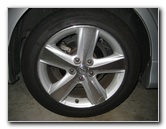 Camry Rear Wheel |
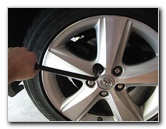 Loosen 5 Lug Nuts |
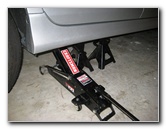 Raise Rear of Vehicle |
| This
automotive maintenance "how-to" guide was specifically written to
assist owners of the XV40 sixth generation (2007, 2008, 2009, 2010 & 2011) Toyota Camry sedan
in replacing the rear brake pads. Owners of other Toyota, Lexus or Scion vehicles such as the Corolla, Matrix, Yaris, Avalon, Venza, RAV4, FJ Cruiser, Highlander, 4Runner, Sequoia, Land Cruiser, Tacoma, Sienna, IS 250, IS 350, ES 350, GS 350, LS 460, tC, xB, xD, iQ and the Toyota Aurion in Australia may also find guide to be helpful. To complete this rear brake job requires the following tools: a floor jack, jack stands, a tire iron, a 14mm socket with ratcheting wrench, and a "C" or "F" clamp.A few compatible aftermarket brake pads for the 2007-2011 Toyota Camry with their part numbers include the following: Akebono ACT1212, Bosch BP1212, Wagner QC1212, Beck/Arnley 0891756, Raybestos PGD1212C, Bendix D1212, Monroe CX1212, Toyota 04466-06090, ACDelco 17D1212CH, and Centric 105.1212. |
||
|
|
||
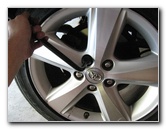 Tire Iron Remove Lug Nuts |
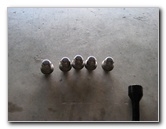 5 Lug Nuts Removed |
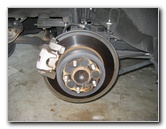 Rear Brake Rotor & Caliper |
| The first few steps
are to chock the front wheels to prevent the vehicle from moving, loosen the
lug nuts on the rear wheels, raise the car with the floor jack and support
it with at least two jack stands. Once the rear wheel is off the ground, spin off the five lug nuts and carefully pull off the wheel. Behind the wheel you'll find the rear brake rotor, caliper and caliper bracket. |
||
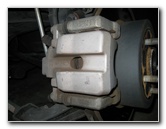 Rear Brake Caliper |
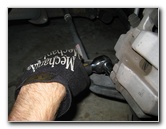 Loosen 14mm Caliper Bolt |
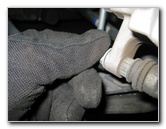 Remove Lower Caliper Bolt |
| Use the 14mm socket with a ratcheting wrench to loosen and remove both the upper and lower caliper bolts. | ||
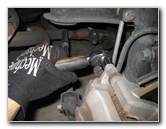 Loosen Upper 14mm Bolt |
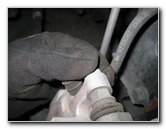 Remove Upper Bolt |
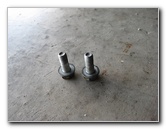 Two 14mm Bolts Removed |
| Pull the caliper
off the old pads and away from the brake rotor.
In order for the caliper to fit over the thicker new brake pads, the brake caliper piston will need to be compressed backwards using a "C" or "F" clamp. (This step is not pictured below.) First remove the cap on the brake fluid reservoir in the engine bay to allow the brake fluid to more easily move backwards through the system. Place one of the old brake pads over the caliper piston to help evenly distribute the force and attach the "F" clamp. Very slowly tighten the "C" or "F" clamp to compress the piston. Only compress the piston as far back as the rubber dust boot.
Repeatedly check the level of brake fluid in the
reservoir while compressing the piston to ensure that it does not overflow.
Brake fluid is extremely corrosive and can easily damage any of the vehicle's painted surfaces. Use some brake parts cleaner spray and a shop rag to thoroughly clean off the brake rotor, caliper and bracket.
|
||
|
|
||
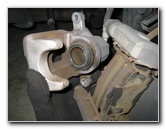 Compress Caliper Piston |
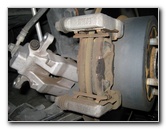 Old Rear Brake Pads |
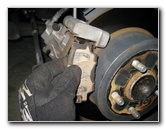 Pull Off Old Rear Pads |
| Carefully pull the
two caliper pins out of the bracket while trying to avoid tearing their
rubber dust boots. If the caliper pins are well lubricated, re-insert them. If the caliper pins look dry, apply a generous layer of synthetic brake parts lubricant grease to them. Re-install the caliper pins into their rubber dust boots and check that they move freely within the caliper bracket. |
||
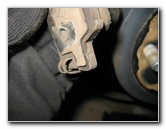 Wear / Squeal Bar |
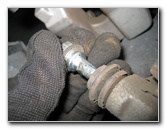 Pull Out Caliper Pins |
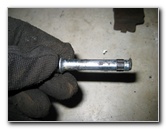 Lubricate Caliper Pins |
| Pull off the old
brake pads from the rotor making a mental note of how the wear or "squeal"
bars are orientated.
On this 2010 Toyota Camry, there is a wear bear were situated at the bottom of both the inner and outer brake pads. I recommend buying the Akebono ACT1212 ceramic rear brake pads since they have excellent reviews on Amazon. |
||
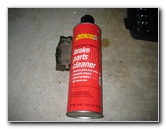 Brake Parts Cleaner Spray |
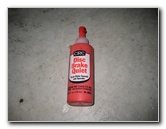 CRC Disc Brake Quiet Gel |
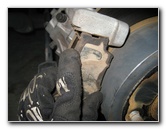 Install New Brake Pads |
| To help prevent braking noise, an optional
step is to apply some CRC Disc Brake Quiet gel or a similar product to the rear of the brake pads
where they come in contact with the brake caliper.
Do not apply anything to the friction surface of the new pads and try to avoid touching them with oily hands. |
||
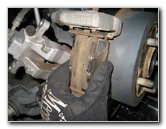 Push Pads Against Rotor |
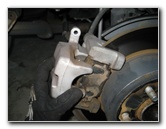 Lower Caliper Over Pads |
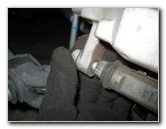 Insert Lower Caliper Bolt |
| If the new
set of rear brake pads came with new metal pad abutment or "anti-rattle" clips, remove the old ones
from the caliper bracket and install the new ones in their place. Apply some brake caliper grease to the bracket and pad abutment clips where they will come in contact with each other or the new pads. Install the new brake pads into the caliper bracket and push them flush against the brake rotor. Lower the caliper over the new brake pads. If the caliper won't fit over the pads, compress the caliper piston back a bit more and try again. |
||
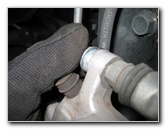 Insert Upper Caliper Bolt |
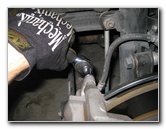 Tighten Caliper Bolts |
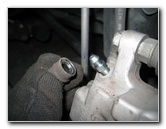 Brake Line Bleeder Valve |
| Line up the hole in
the caliper with the slider pin in the bracket and insert the caliper
bolts by hand.
Tighten the caliper bolts snugly to just past hand tight or about 25-30 ft lbs of torque. If necessary, use a thin 17mm cone spanner wrench to keep the caliper pin from spinning when you tighten the caliper bolt.
If your brake pedal previously felt mushy or spongy, the brake fluid may be contaminated with water or the brake lines may contain air bubbles. It would be best to bleed the brake lines at this time in order to flush out the old fluid and replace it with new DOT3 brake fluid. For more on this topic, check out my Brake Line Fluid Bleeding DIY Guide. |
||
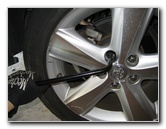 Tighten Lug Nuts |
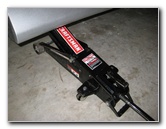 Lower Floor Jack & Stands |
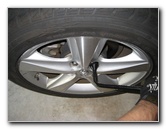 Torque Lug Nuts |
| Replace the rear
wheel and twist on the five lug nuts by hand to prevent cross threading them.
Then tighten the lug nuts most of the way with a tire iron.
Support the vehicle with the floor jack, remove the jack stands, and lower the car until the rear wheel holds enough weight to keep it from spinning. Tighten the lug nuts to about 76 ft-lbs of torque. It would be best to use a torque wrench or an electric impact wrench with a torque stick to properly tighten the lug nuts. Pump the brake pedal several times to restore the brake line pressure. Check the brake fluid level in the reservoir and verify that it is at the "MAX" (maximum) line. If it is below the "MAX" line, add some fresh DOT 3 brake fluid. Once the brake fluid level is correct, replace the brake fluid reservoir cap by twisting it on clockwise. To break in your new brake pads, drive normally for the first 200-300 miles while trying to avoid any hard or "panic" stops which may glaze the new brake pads and cause them to squeal and/or perform poorly. It's also a good idea to regularly examine your driveway for drips of brake fluid which may indicate a slow leak, check the brake fluid level in the reservoir, and also check that all the lug nuts are still tight. For more,
check out my
Toyota
Camry Repair & Maintenance Guides page. |
||
| If you found this guide to be helpful,
please consider making a small donation by clicking on the PayPal.com
"Donate" button located to the right of this paragraph. Thank you!
(Note: I am not a registered charity. Donations are not tax deductible.) |

